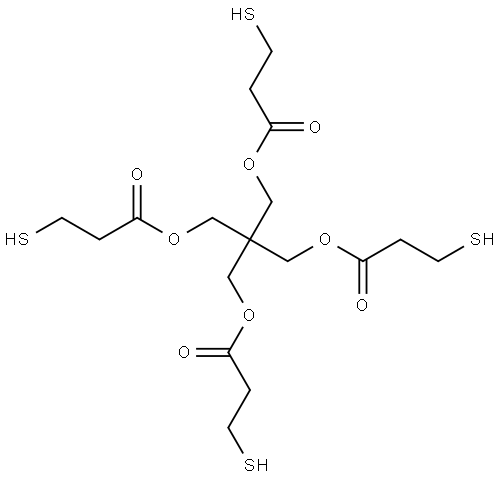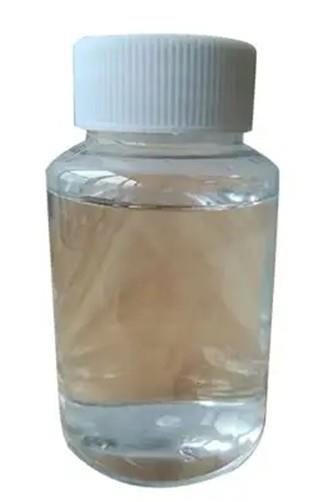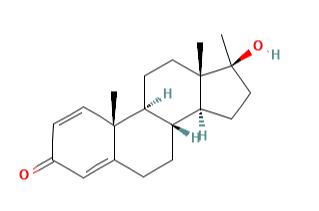Synthesis and Application of Pentaerythritol tetrakis(3-mercaptopropionate)
General description
Pentaerythritol tetrakis(3-mercaptopropionate) is a clear liquid with no color to almost no color. Environmental exposure to the substance can occur from: indoor use and outdoor use, resulting in attachment to or on a material (e.g. paint and coatings or adhesives in adhesives). It can be used for organic synthesis of intermediates and used for UV coatings, ink, adhesives and other polymerization in the modifier, crosslinking agent, acid ion exchange catalyst, low temperature curing agent.
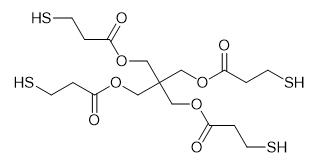
Fig. 1 The structure of Pentaerythritol tetrakis(3-mercaptopropionate).
Synthetic routes

Fig. 2 The synthetic of Pentaerythritol tetrakis(3-mercaptopropionate).
Add 118.28 g 3-mercaptopropionic acid, 34.04 g pentaerythritol, 7.83 g 4-dimethylaminopyridine (DMAP), 82.79 g N to a 500 ml four-mouth flask equipped with a blender and thermometer. N 'dicyclohexyl carbimide (DCC) and 182.79 g dichloromethane; When pentaerythritol is completely dissolved, the heating is turned off and the reaction starts at room temperature. During the reaction, the temperature is controlled at room temperature and the reaction time is 4-6 h. In the process, the content of 3-mercaptopropionic acid in liquid chromatography is used to judge the end point of the reaction; Pentaerythritol and 3-mercaptopropionic acid in the esterification process of the by-product pentaerythritol three (3-mercaptopropionic acid) ester will be produced, so in determining the end point of the reaction, The molar amounts of 1 part of pentaerythritol tri (3-Mercaptopropionic acid) ester and 4 (3-mercaptopropionic acid) ester in the reaction system should be set as n1 and n2, respectively, and the molar amount of the remaining 3-mercaptopropionic acid in the system should be n3. When n3/ (3*n1+4*n2) is 0.45:4, the reaction end point can be considered; After the completion of the reaction, the white solid in the reaction system was separated by filtration, and the filtrate was placed in a separating funnel and washed three times with 10wt% Na2CO3 solution. The amount of alkali solution was 25% of the total mass of the reaction solution each time, and the pH value was controlled at 7-8. The organic phase was collected after standing for 15 min. The organic phase obtained after three times of collection was washed three times with saturated NaCl solution to neutral, and the amount of saturated NaCl solution was 17% of the weight of the organic phase each time to obtain homogeneous organic phase; Dichloromethane and trace water were removed by distillation of the net organic phase under vacuum of -0.098MPa and water bath temperature of 40℃ for 2 h. 98.13 g of Pentaerythritol tetrakis(3-mercaptopropionate) was obtained in colorless liquid form. The purity of the product was 97.5% by liquid chromatography and the yield was 80.32%. [1].
Application
Preparation polymeric degradable networks
Thiol-ene click reactions of pentaerythritol tetrakis(3-mercaptopropionate) with pentaerythritol tetraacrylate and trimethylolpropane triacrylate were used to prepare polymeric degradable networks. The structure and properties of these networks were studied using Fourier-transform infrared and Raman spectroscopy, thermal gravimetric analysis and scanning electron microscopy. Degradation of these materials was evaluated in different media including phosphate buffer with and without esterase as well as in oxidative environment with hydrogen peroxide. Exposure of the samples to these media results in their degradation. Slow hydrolytic degradation was observed in phosphate buffer and it was not accelerated by the presence of an enzyme. Faster degradation is observed in solutions of hydrogen peroxide. The mechanisms of this degradation are discussed [2].
Model thiol-click glassy networks with low shrinkage and sharp glass transition temperatures are studied down to cryogenic temperatures to relate viscoelastic damping to changes in microscopic hole volume. Networks synthesized by polymerization of divinyl sulfone with pentaerythritol tetrakis(3-mercaptopropionate) (PETMP), trimethylolpropane tris(3-mercaptopropionate) (TMPTMP), and pentaerythritol tetrakis(2-mercaptoacetate) (PETT) were studied to similar to 50 K using positron annihilation and thermal analysis methods. Across the glass transition temperature, overall volume expansivity is dominated by expansion of microscopic holes. Beneath T-g, holes contract upon cooling and then become static with negligible expansivity at temperatures well above 0 K. A trade-off between complete rigidity of static free volume and viscoelastic damping ability below T-g is discussed. All samples show moderate damping (tan delta > 0.05), and one sample exhibits a prominent beta-transition in its viscoelastic loss spectra. These results indicate the potential for tuning the molecular design of low-temperature glassy networks to optimally incorporate damping with low shrinkage [3].
Preparation of hydrogel
Utilization of animal parts in ex-vivo mucoadhesion assays is a common approach that presents many difficulties due to animal rights issues and large variance between animals. This study examines the suitability of two PEGDA (poly(ethylene glycol) diacrylate) based hydrogels to serve as tissue mimetics for mucoadhesion evaluation. One hydrogel, termed PEGDA-QT, was composed of pentaerythritol tetrakis (3-mercaptopropionate) and PEG and contained free thiol groups mimicking those found in natural mucosa. The other hydrogel was formed by UV (ultraviolet) curing of PEGDA and mimicked the mechanical property of mucosa but not its chemical constitute. When ranking different first generation mucoadhesive polymers using a tensile assay, both hydrogels showed good agreement with the ranking achieved for porcine small intestine. However, only PEGDA-QT and porcine small intestine shared a similar displacement curve. The same ranking for PEGDA-QT and porcine small intestine was also observed when comparing a second-generation mucoadhesive polymer, thiolated alginate, to native alginate. Our findings suggest that PEGDA-QT could serve as a replacement for porcine small intestine in both mucoadhesion evaluations using a tensile machine and the flow-through method for first and second-generation mucoadhesive polymers [4].
Preparation of Poly(caprolactone) networks
Poly(caprolactone) networks are well-studied shape-memory polymers owing to their high fixity and recovery, their ability to store large amounts of elastic energy, and their tunable shape-triggering temperature. To elucidate the influence of network structure on shape-memory features, poly(caprolactone) networks are prepared by reacting different molecular weight diacrylate prepolymers with trifunctional (trimethylolpropane tris(3-mercaptopropionate), 3T) or tetrafunctional (pentaerythritol tetrakis(3-mercaptopropionate), 4T) crosslinkers. Networks from 4T crosslinkers generally exhibit higher gel fractions, more elastically active strands, and superior shape-memory properties compared with networks from 3T. Melted elastomers exhibit stress-strain behavior well described by the neo-Hookean model. How the state of crystallization during the cold-drawing process has a large effect on the draw stress, the network's shape fixity, and its elastic storage capacity is shown. Finally, the working strain range of networks is evaluated. Cured elastomers prepared from prepolymers with different molecular weights can store and release large amou
Related articles And Qustion
See also
Lastest Price from Pentaerythritol Tetra(3-mercaptopropionate) manufacturers
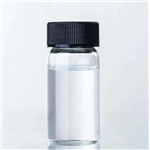
US $18.00-12.00/kg2025-11-03
- CAS:
- 7575-23-7
- Min. Order:
- 1kg
- Purity:
- 99%
- Supply Ability:
- 300tons
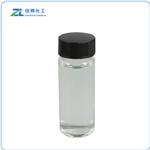
US $70.00/kg2025-04-15
- CAS:
- 7575-23-7
- Min. Order:
- 1kg
- Purity:
- 99
- Supply Ability:
- 5000
